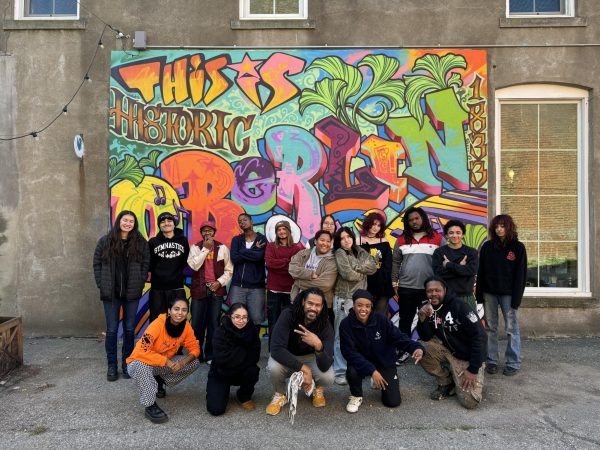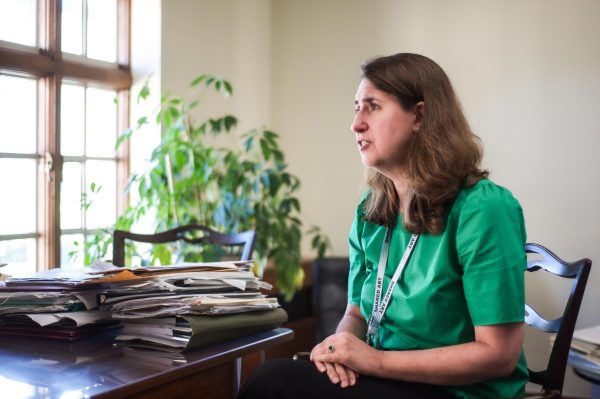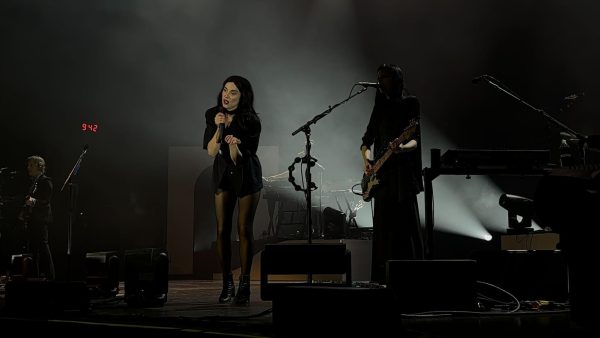Dead South Brings Dark Punk Folk Music to Cat
When I saw, “Honk if you love rhubarb” written in dirt on the back of The Dead South’s trailer, I knew that Wednesday night’s concert was going to be interesting. Though I arrived half an hour early, the Cat in the Cream was already more than half full with people from not just Oberlin, but as far afield as Houston and Columbus; the band had performed in Columbus Tuesday night, and some audience members had followed them to Oberlin to see them perform a second time. By the time the concert started, there was standing room only.
The Dead South came out looking like a group of punk Amish, dressed in distinctive dark clothes. The lead singer, Nate Hilts, was sporting the largest hat I had ever seen. The band, rounded out by Scott Pringle, Eliza Mary Doyle, and Danny Kenyon, immediately launched into their first song. The music was fast and wild, a whirlwind of guitars, mandolins, and banjos, reminiscent of Mumford and Sons or The Lumineers. According to The Dead South’s website, they have been described as “Mumford and Sons’ evil twins.” The music had a distinct Texan or otherwise Southern flair, even though the band is from Saskatchewan, Canada. The combination of extremely fast strumming with a thumping beat was almost overwhelming, and pushed the instruments to their limits. One of the band’s assistants even had to keep changing out broken strings from the guitars, banjos, and mandolins. Although their strings broke, the musicians kept on playing with the same vigor. They stomped out and danced to the beat, and encouraged the audience to dance and clap along.
The band members, especially Hilts, interacted with the audience throughout the performance and showcased an excellent sense of humor. After the band explained that they were unable to bring their merchandise over the U.S.-Canada border, an audience member called out “Thanks, Trump!” and the band made a couple of well-received jokes at the President’s expense. They also took requests from the audience for some of the songs they played.
The songs themselves were mostly Southern, bluegrass, or classic folk songs with a punk aesthetic. Most of the music had a driving beat and a lively tune with a dark twist. For example, “Miss Mary” — according to Hilts, his mother’s least favorite song — was a nervous little song about a woman abusing prescription pills and murdering her romantic partner. Another piece, “In Hell I’ll Be in Good Company” had a quick beat that was good for dancing but, as the title suggests, the lyrics were more forbidding than the music. The Dead South even tried out a new song during their set: “Black Lung.” The song itself stood out from the rest of their performance because it had a more sinister tone; it was slower, more haunting, and deeply memorable.
The performance was captivating and genuinely fun. The audience could barely tear their eyes away from the band and, if I were the dancing type, I would have gotten up and danced along. They are a great choice for fans of bands like Mumford and Sons, The Lumineers, and Lord Huron, and folk and country aficionados alike. If the artists had actually been able to bring their merchandise, many would have bought an album, or at least a button. I hope that The Dead South comes back to Oberlin while I’m still here. I would definitely go see them again.





